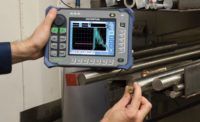SANTA BARBARA, CA — Bruker recently sponsored the sixth AFM BioMed International Meeting on AFM in Life Sciences and NanoMedicine.
Held at the Sanford Consortium for Regenerative Medicine in La Jolla, Calif., the conference brought together more than 125 scientists from around the world. The technical program featured invited talks from leading bio researchers with over 100 oral and poster presentations on topics ranging from imaging and integrative atomic force microscope developments to biomechanics and biomedical applications.
Bruker announced the release of BioScope Resolve, a biological atomic force microscope (bioAFM) that features the highest resolution imaging and most complete cell mechanics capabilities available for use with an inverted optical microscope. Bruker also hosted two hands-on pre-conference workshops.
“AFM BioMed investigates how atomic force microscopy (AFM) solves relevant biological bottlenecks and provides innovative solutions for healthcare,” explained UC San Diego Associate Professor Adam Engler, AFM BioMed conference chair. “The meetings act as a forum to promote innovative cross linked research and highlight the power of integrating AFM with other optical and analytical techniques. This year’s program was a tremendous success, setting a new AFM BioMed record for geographical diversity, with presentations from 20 different countries across 4 continents.”
In addition to the pre-conference workshops featuring the new BioScope Resolve and the Dimension FastScan-Bio AFMs, Bruker hosted a social event for attendees at the Stone Brewing World Bistro and presented an award for the top poster presentation. This year’s winner was Galja Pletikapi? from the Ru?er Boškovi? Institute. Other poster award winners included Dario Ossola from ETH Zurich in Switzerland, Duckhoe Kim from Columbia University, and Alice Pyne from University College London.
The event provided the perfect venue for the introduction to BioScope Resolve. The new system incorporates Bruker’s proprietary PeakForce Tapping technology to enable researchers to achieve both the highest resolution imaging and piconewton level force measurements on biological samples. Resolve also provides real-time correlation of atomic force microscopy and optical microscopy data sets to provide unique insights into life sciences research. Ultimately, BioScope Resolve enables imaging and mechanical property mapping of the biological detail of cells, tissues, and biomolecular structures never previously observed with a bioAFM on an IOM.
“After careful evaluation we selected BioScope Resolve due to its highest resolution capability,” said Professor Bin Li of the Shanghai Institute of Applied Physics, China, at the conference. “We believe it will serve our needs well.”
For more information, visit www.afmbiome.org.

